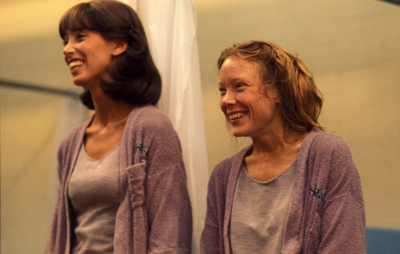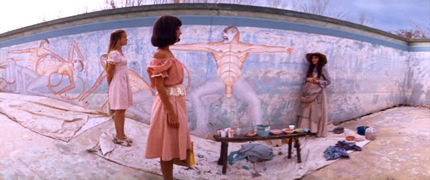
 |
|
|
|
Robert Altman was a highly contentious topic in the 1970s -- one either heard his latest film praised to the heavens or condemned as more auteurist self-indulgence. M*A*S*H and McCabe and Mrs. Miller were substantial hits, but most of the rest of Altman's pictures didn't do well at all. Buffalo Bill and the Indians and The Long Goodbye exhausted audiences with their odd refusal to behave like normal Hollywood fare. Quintet established a record for walkouts; Images barely got released. 1977's 3 Women is the most satisfactory of Robert Altman's ethereal dream movies. The star cast and the strange goings-on are of sufficient interest to keep most audiences in their seats, even though many resented the film by the time the house lights came up. And who could blame them? 1977 was the year of Star Wars, and here was a weird story about odd personalities and shifting identities that operated under an impenetrable dream logic. 
The story is a weird examination of atypical women. Shy and guileless Pinky Rose (Sissy Spacek) comes to work at a Palm Springs spa for the aged and is taken under the wing of Millie Lammoreaux (Shelley Duvall), a clueless young woman shunned by her associates for being terminally uncool. They share an apartment and interact with their landlords Willie and Edgar Hart (Janice Rule and Robert Fortier), who also run a Western-themed bar and recreation spot called Dodge City. But Pinky becomes a strain on Millie's already strained life -- especially after a medical emergency in which the odd girl seems to be "reborn" with an entirely different personality, one that seems to be actively absorbing Millie's identity. "Any dream is fine unless it has stupid melting clocks in it." -- Salvador Dali Dali didn't actually say this, but it helps to know that the bizarre goings-on in 3 Women were inspired by a dream experienced by its director. The rest of the story was sketched in by a writing helper uncredited in the movie (but listed above). Altman supposedly shot his film without a script. He tapped Shelly Duvall for some passages of dialogue and narration. Altman certainly shows faith in his actors and the story situations he invents for them. In the case of 3 Women his ad hoc creative style produces a weird yet compelling atmosphere. Millie Lammoreax is Shelley Duvall's best characterization, an original that we all recognize. She's the socially clueless girl who accepts the vision of life found in magazines and advertisements. In her coordinated pastel skirts that always get caught in the door of her Pinto, she's a pathetic sight. She cultivates a life of trivial snacks and just-so fashions to compensate for an absent personality, or to be more accurate, a personality bludgeoned out of existence by social rejection. Poor Millie is everyone's doormat. She may not be overly intelligent but she is sincere, and her painfully lame attempts to make friends at her singles apartment building typically end in more rejection and humiliation. She's put up a wall of denial against the blatant cruelties and personal insults of her peers. It's no better for Millie at work, where her passive habits make her an easy target for her uncaring, cruel employers (who seem unusually keen not to have their books examined). Mostly Millie is just lonely, as seen by her one-sided conversations with people who ignore her. This is what makes the arrival of open-faced, seemingly innocent Pinky seem such an opportunity. When Spacek's innocent, borderline infantile Pinky calls Millie the most perfect person she knows, Millie's face lights up in delight -- as it dawns on her that her new friend is not pulling her leg. 
Much in 3 Women transpires in a dreamy, flowing state. Altman's long-lens master shots tend to drift across scenes. The story is not told in cuts but in shots as fluid as the incessant water symbolism -- spas, pools, empty pools, liquids, blood, even the foreground distortion through which some scenes are viewed. Like a haunting refrain, the visuals keep returning to artist Bodhi Wind's disturbing murals, seen on various surfaces including a new pool decoration. Wind's artworks feature animalistic monster humans with distorted sex organs. We see them being painted by the girls' pregnant, silent landlord Willie, as if expressing a ferocious world hidden under the dull everyday desert. None of the women has a "normal" love life. Willie seems alienated from her boozing, wild west crazy husband Edgar. Pinky seems too undeveloped to understand sex. The pathetic Millie is a pushover for whatever male acquaintance wants to get laid, but she's shocked to hear Pinky's aged parents engaging in loud sex from the next room. The 'strange world' of 3 Women shares a lot in common with that of David Lynch. The show would be an empty exercise if it weren't for Altman's engaging play with a spooky kind of identity theft: after a traumatic incident, Pinky seems to devour Millie's personality as if she were a seed pod in Invasion of the Body Snatchers. This shaggy-dog story eventually dovetails to a conclusion that resolves as a genuine human puzzle. Yet the film is sufficiently interesting to reward us even when all ends without an answer in sight. Pinky starts out as such a ninny that we think she might be mentally challenged, like Gelsomina in Fellini's La Strada. Then Altman starts playing tricks on us. Like Ripley in the Patricia Highsmith novel, Pinky appears to be appropriating Millie's identity one detail at a time. Waking up from a coma in a hospital room, her personality changes 180 degrees, indicating a weird transformation or some kind of sinister conspiracy. Pinky is soon playing a dominant role, manipulating Millie and throwing her weight around like Dirk Bogarde in The Servant. Both women become involved with Willie's foolish faux-cowboy husband Edgar. Millie has sincerely set aside her life to come to her roommate's aid, as if Pinky were her own child. For her trouble Millie loses her job and suffers even more personal indignities. 
The end dissolves into a kind of limbo-nightmare, a new puzzle that somehow redeems the absence of a standard finish. After the untimely exit of Edgar, our three women change roles to form a new female family with new identities for all. Savant has pretty good BS antennae, yet this particular artsy puzzle didn't come off as flip fakery. If one is going to fashion an oneiric meditation on identity featuring plastic, interchangeable personalities, this isn't a bad way to go. Criterion's Blu-ray of 3 Women was one of their first under a licensing deal with Fox, and it's a beauty. I saw the movie in a studio screening when new, and remember thinking that it would never, never work on commercial television. I also wondered if Fox might just hide it away forever: I was one of maybe ten people in the industry gathering that liked it. The transfer on the 2004 Criterion DVD looked quite good, but this HD encoding really nails down the film's dreamlike quality, with rich images that overpower Altman's lazy preference for telephoto zoom coverage of some scenes. Actually, the random feel of some of the long-lens shots enhances the movie's hallucinatory qualities. For once a Criterion disc hasn't much in the way of extras. It does have Robert Altman's commentary, which is a considerable help to understanding his method. In this case the method seems to be to establish a situation and encourage his capable actresses to free-associate their performances. Altman explains that the story idea came to him in a literal dream, a dream that included the title, the names of the actresses and even a 'dream scene' where he told his associates to start prepping the film. Altman drifts between topics and lectures and repeatedly tells us that his movies are like paintings. But he also communicates his organic approach to filmmaking and convinces us of his efforts to be different and unique. He's especially good at deflating the notion that everything in his films is a result of conscious intention. Altman sets up moods where interesting things can happen. He finds actresses we can't take our eyes off of, and frees them to improvise within his loose guidelines. In this case the result is entirely satisfactory. Duvall and Spacek were never better. 
Veteran Criterion disc producer Karen Stetler assembles two trailers, tv spots, a still gallery and a good liner essay by David Sterrit of the Christian Science Monitor. The TV spots suggest a non-existent murder mystery, in search of a box office hook for the decidedly uncommercial movie. Curiously, the film's diary-like poster is a graphic layout of the exact contents of the theatrical teaser -- three still photos, with three quotes from Millie/Pinky's cryptic diary. The beautifully designed packaging and menus use more Bodhi Wind imagery.
On a scale of Excellent, Good, Fair, and Poor,
3 Women Blu-ray rates:
Reviews on the Savant main site have additional credits information and are often updated and annotated with reader input and graphics. Also, don't forget the 2011 Savant Wish List. T'was Ever Thus.
Review Staff | About DVD Talk | Newsletter Subscribe | Join DVD Talk Forum |
| ||||||||||||||||||